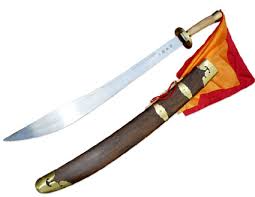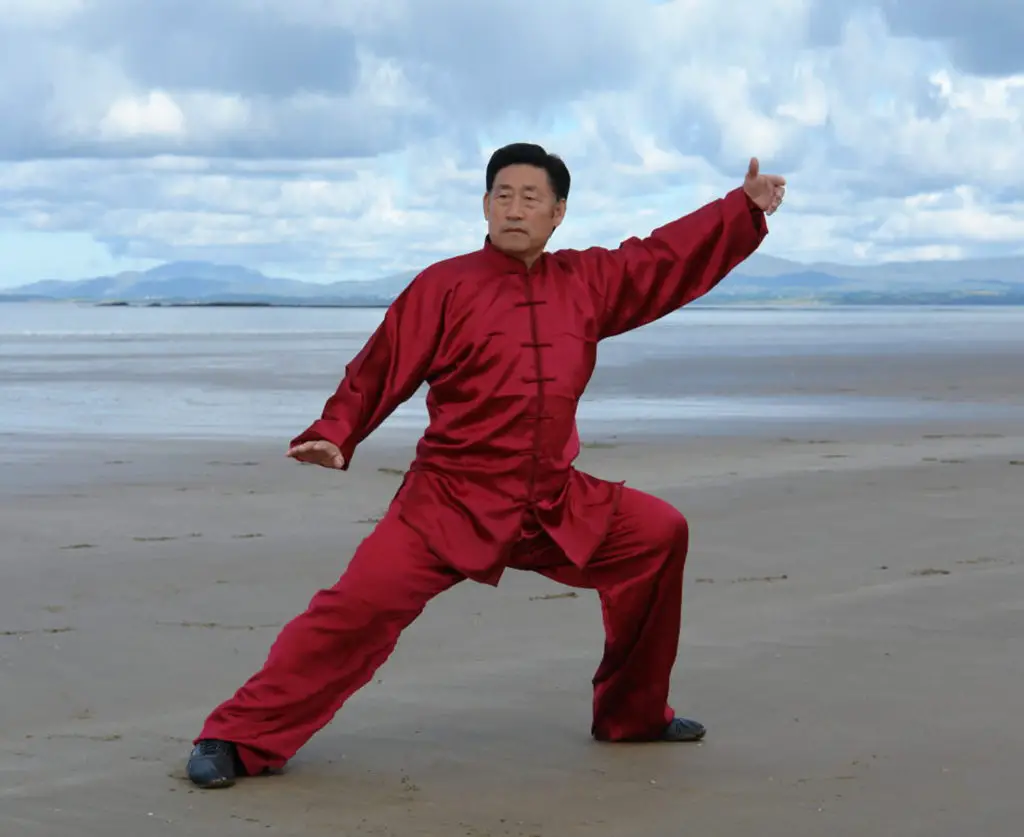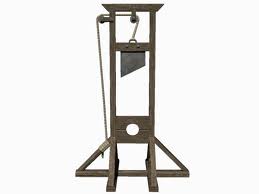For those of you looking to learn a weapons form that is fun, fast, and short, the tai chi broadsword is the way to go. Aside from improving your openhand form in two unique ways because it teaches circular and big movements, it also can get you in shape physically.
The tai chi broadsword or dao is the sabre of the Chinese weapons family. It is just under one meter long on average, has a flexible blade that is sharp on only one side, and widens at the end like a scimitar. The broadsword form is typically short and fast with lots of jumps, strikes, and circular movements.
To get the most out of training with the broadsword we have to understand how to use the different parts of the weapon, learn what the purpose of the spinning is, and see how this relates back to making you better overall at tai chi. Let’s talk a little bit about the broadsword and then dive into the supercool energy and power that the form teaches.
Parts of the Tai Chi Broadsword

Understanding the anatomy of a broadsword is pretty important because we use the entire weapon when fighting. We are not just cutting with the blade, we are pushing on the unsharpened top of the blade, using the flat side of the blade, and striking with the handle throughout the form. This is why the form is so versatile and directly translates into fighting with bats, canes, golf clubs, etc.
- The blade is sharp on the upper two thirds.
- The back edge is dull – so you can put your hand on it and push or block.
- Unlike the straight sword, you can put your hand on the wide flat side to block an opponent’s weapon.
- There is a blood groove which allows the weapon to be withdrawn from the opponent after a thrust.
- The guard protects the hand from other weapons sliding down the blade.
- The handle where you hold the sword is wider in the center so you can maintain control while changing your grips. For example, swinging the sword around the body requires you to let go with the bottom three fingers.
- The pummel at the end of the handle can be used to hit people on top of the head or thigh.
- The flags on the end of the broadsword cause distraction but also give you feedback about how correctly you are circling the weapon.
What Are the Benefits of Studying the Tai Chi Broadsword?
To understand the broadsword we need to dive into two properties of physics. Nerds rub your palms together in anticipation. Non-science buffs, breathe deep and give me 35 seconds. The broad sword is one of the shorter forms which means you can learn it faster but I will get to that in a minute.
The broadsword teaches circular movements
We have two circular forces, centrifugal and centripedal.
Centrifugal Energy or Motion
Aka spinning out – This is what happened when you asked your brother to push you on the merry-go-round and he didn’t stop until you flew into the bushes. The tai chi broadsword form has several places where you cross-step behind on leg and then spin the body around. This gives the body an acceleration to perform the huge lift-off for the jumps.
Centripetal Energy or Motion
Aka spinning in – centripetal comes from “center + seek” in Latin. This is what happens when an ice skater brings her hands in towards her body. There is an increase in force and power as you spin and bring your arms and the broadsword in towards the body. You can imagine that this would also increase the force when applied to a cutting surface. There are several places in the tai chi broadsword form where the body turns 360 degrees and the blade cuts parallel to the ground. By bringing the sword hilt close to the body, you speed up and bring your balance to the center of the body.
Here is an example of what I am talking about. Around 00:58 you can see Wang Xian circle, jump, and strike.
The broadsword improves balance
Understanding and being able to move when their is external and internal pressure is really important to your health and how you do the regular tai chi form. When people are off balance and stumble, typically they are responding poorly to some force that they have come up against. In older people this becomes dangerous because falls can result in broken bones.
Balance and “Empty Steps”
We know that in tai chi, all steps are empty (not weighted) and the body weight is transferred onto a foot only after a step. When someone does the the tai chi form poorly, they step and have all their weight land with their foot. A better practitioner steps with an “empty step” that the haven’t committed their weight to and then transfers their weight forward. The tai chi broadsword helps teach this motion and make it a habit.
The broadsword teaching how to stretch and expand
In the broadsword form, there are huge sweeping motions with the arms. Imagine pressing both arms straight above your head and then moving your hands down and out to your sides. This is so great for your health because you are taking big breaths and working through all the tight muscles that have been collapsed throughout the day. Many of us spend our days bent over a keyboard or bent over while working. The broadsword form combats this by moving us up, back, and stretching us out.
From a tai chi perspective, many novices do their form with really small movements. Imagine a person standing with their arms bent at 45 degree angles rather than stretching further out. For those of us that don’t have a teacher and are learning on our own, weapons like the broad sword can teach these essential tai chi energies without a teacher being present. Here is a perfect example of what a wide expansive posture looks like in the image of Grand Master Chen Xiaowang.

The broadsword teaches how to add speed to power

The broadsword is heavier, big, and sharp only on one edge. It is most effective when it is fast and coming down.
He’s the problem, the guillotine is in your hands and unless you are Braveheart, you are probably too close to get an effective wind up. The tai chi broadsword form teaches you how to wind up using small fast circle so that you don’t have to retreat and charge everyone time you want to attack. In practical terms, you can imagine how effective this is if you have a bat or half a pool cue and are in a crowded bar. At a higher level, the broadsword form teaches you how to expand and contract during these circles using internal strength so that you can the full brunt of the force to bare on the single edge of a blade.
If you watch the form performed correctly, the body travels backwards first, the blade arcs in a circle following the bodyweight and circles back forward during the attack. To get the idea, imagine dangling a weight on a string that you want to hit someone on the top of the head with. You have to swing it down and back before bringing it around.
Here is an example from the form. Starting at 4:14 you will see circles that are overhead hacking down and circling around parallel to the ground. Chen Style Tai Chi Single broadsword – Zhu Tiancai
The broadsword is an introduction to how the human body can generate huge force in a small space so that you don’t need a running start. It also teaches you how you can take advantage of gravity to create quick powerful energy that you are going to bring down onto a single blade. If that isn’t enough, it’s also quite physically demanding so it whips you in shape and challenges your balance too!
Where can I find a tai chi broadsword?
There are many types of broadswords to choose from and what you use can impact your progress, not to mention your wallet! So here is what we tell our students when they are looking to start or improve their broadsword form.


